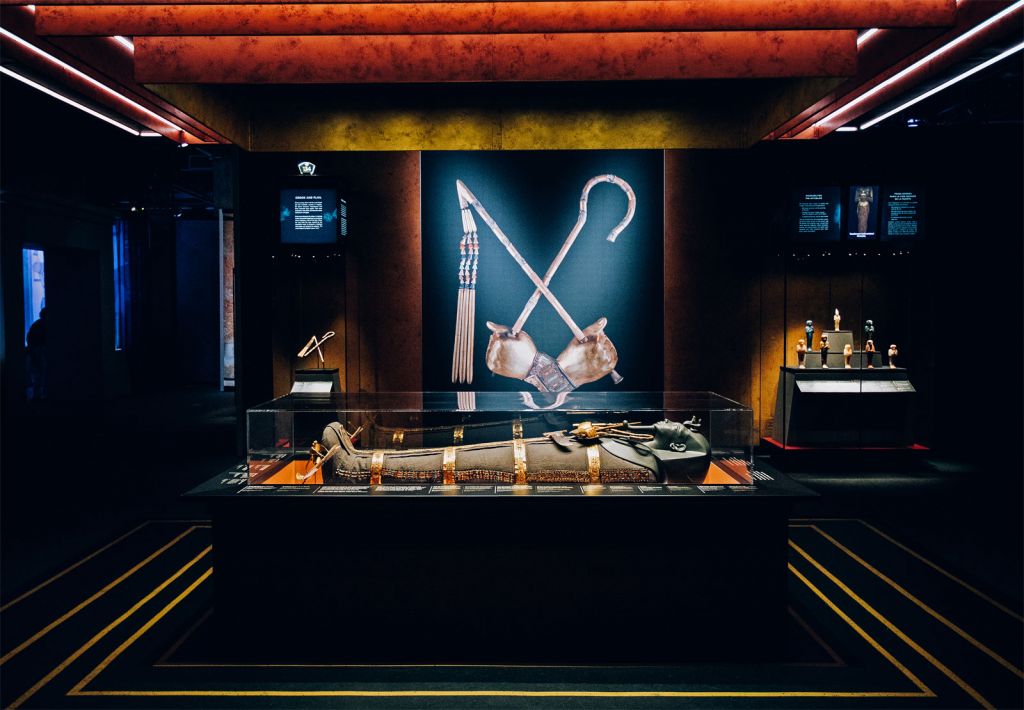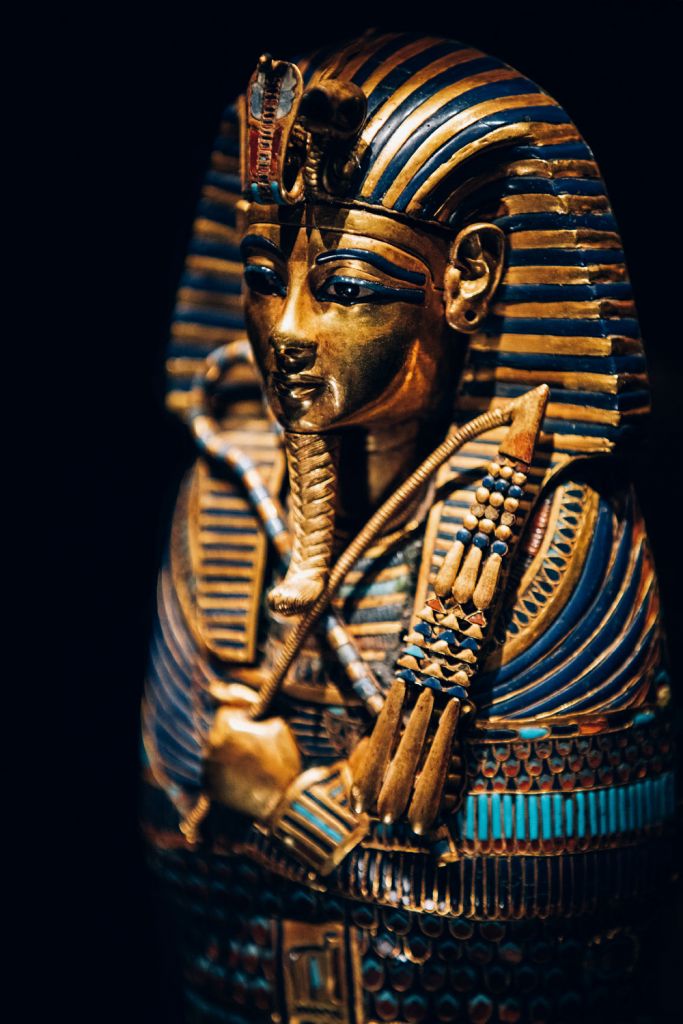

Gina Baksa pays homage to the most famous Egyptian Pharaoh of them all during her visit to the Tutankhamun: Treasures of the Golden Pharaoh Exhibition at the iconic Saatchi Gallery.
The discovery of King Tutankhamun’s tomb near Luxor in November 1922 became one of the world’s most legendary archaeological finds. It launched the Egyptian Boy King into global superstardom.
Leading the expedition, eminent Egyptologist Howard Carter, funded by British aristocrat Lord Carnarvon, was on his last dig in the Valley of the Kings. Time and money were running out.
At the final hour, the duo struck gold when they discovered the tomb, and Carter uttered the immortal words: “Yes, wonderful things!” in response to his benefactor asking him what he could see behind the chink in the chamber doors.


The twelfth king of Ancient Egypt’s 18th Dynasty was just 19 when he died. Originally thought to have been murdered, recent scans of his mummy suggest that he may have had malaria.
The small size and irregular shape of Tutankhamun’s tomb suggest that he passed away well before his own tomb was ready.
Crammed full of priceless ancient artefacts, including the solid gold funeral mask that became the Boy King’s iconic emblem, it took Carter ten years to clear the chamber and catalogue each piece, most of which are still housed at the Egyptian Museum in Cairo.
Fast forward to 2020 and King Tut’s rich legacy is currently on a world tour with over 150 authentic tomb objects now on show at London’s Saatchi Gallery, many on their first journey outside of Egypt.
You won’t get to see the spectacular funerary mask that lucky visitors to the 1972 exhibition would have witnessed. However, what we do experience on the London leg of the worldwide tour are breathtaking examples of exquisite craftsmanship in gold, wood, precious stones and metals that were crafted specifically for Tutankhamun’s journey to the afterlife.
I’ve had a compelling fascination with Ancient Egypt that has led me to take groups to visit the temples and pyramids of this amazing country. So, I was excited to spend time among these extraordinary displays of wealth and reverence for the afterlife.
The Tutankhamun – Treasures of the Golden Pharaoh Exhibition spreads across several large rooms at the cavernous Saatchi Gallery near Sloane Square.
Each room is suitably atmospheric with subdued lighting and subtle repetitive soundtrack that induces an appropriate dreamlike state.
All exhibits, from the amulets and jewellery to the larger furniture (even Tutankhamun’s bed is here), are displayed in beautifully lit glass cases.
Best of all, the exhibition’s curators have thoughtfully allowed plenty of space around each display, thereby providing enough room to move around each case without being jostled by other visitors.
Especially if you go, as I did, around 4 pm, I feel reverence for these artefacts that were never meant to see the light of day after the tomb was sealed, let alone be witnessed and enjoyed by human beings some 3,200 years after they were sealed in the subterranean chamber in the Valley of the Kings.
Tutankhamun’s extraordinary alabaster wishing cup in the form of an open lotus in full bloom stands on a high display like the Holy Grail itself. It emanates magnetic energy and is decorated with the god Heh seated on a basket.
The life-size amber resin guardian statue of King Tut represents the soul of Tutankhamun before his death. The clothing is made of gold; the sandals are bronze. A gilded wooden shrine with scenes of Tutankhamun and his wife, Ankhesenamun, is an astonishing piece of craftsmanship.
His bed with gold lion’s feet is here… just imagining that Tutankhamun slept here is mind-blowing.
I love the jewellery: the earrings, necklaces, mirrors, rings and amulets, and especially the scarabs, are stunning. All are made from precious stones and intricately set in gold.
The level of craftsmanship is extraordinary here, so I recommend lingering long to savour the majesty and allow yourself to be transported back in time.
The gilded wooden shrine with scenes of Tutankhamun and his step-sister wife Ankhesenamun is exquisite. Tutankhamun’s mummy is not here, but what you will see is a mock-up of his body decorated with folded golden arms holding the flail and crook (symbols of Osiris and Tutankhamun’s kingship) and a scarab beetle atop his chest adorned with amulets and gold.
Eight ornate gold bands held the mummy in place; they are here, too, as well as the scarab, a sacred symbol of rebirth. Take a look at his child’s chair. The boy-king was crowned at the tender age of nine and is a stunning work of art.
The funeral priests in Egypt always mummified the deceased after death. They removed all moisture from the body, extracted the stomach, liver, lungs and intestines and stored them in canopic jars.
It was believed that Tutankhamun’s ka resided in the mummy, which had to be kept intact to allow the magic of rebirth to take place when the deceased’s ba returned as a bird and merged with the ka.
The grand finale of the exhibition is the colossal quartzite statue of Tutankhamun standing sentinel in a gallery of its own. It’s frankly mind-blowing. What Carter and Carnarvon felt when they first opened the tomb must have been indescribable.
Thanks to the eagle eye of water boy Hussein Abdel-Rassoul, who first noticed the steps to the ancient tomb and alerted Carter, Tutankhamun was raised from obscurity to worldwide celebrity status.
The boy-king, whose name had been removed from Ancient Egyptian history, was reborn to become the most famous Pharaoh of them all some 3,200 years after his death.
It’s an astonishingly sensitive exhibition that lingers in the mind and the heart long after visiting. We’ve been told this will be the final King Tutankhamun world tour.
Soon, the treasures will return to Cairo and be housed in a permanent exhibition at the extraordinary new Grand Egyptian Museum near the pyramids, which is due to open later this year.
If you’re thinking of visiting the London exhibition, it runs until the 3rd of May 2020, and I highly recommend buying tickets.
Tutankhamun: Treasures of the Golden Pharaoh Exhibition – Where and How?
The Tutankhamun: Treasures of the Golden Pharaoh Exhibition is located at Saatchi Gallery, Duke of York’s HQ, King’s Road, Chelsea, London SW3 4RY.
For tickets, call 44 (0) 844 248 5028 or purchase www.tutankhamun-london.com.
Opening times:
- Monday, Tuesday, Wednesday, and Sunday – Open from 09:00, with the last entry at 17:30.
- Thursday, Friday, Saturday – Open from 09:00 with last entry at 19:30.
A timed entry system is in place, with tickets allocated every half hour.
